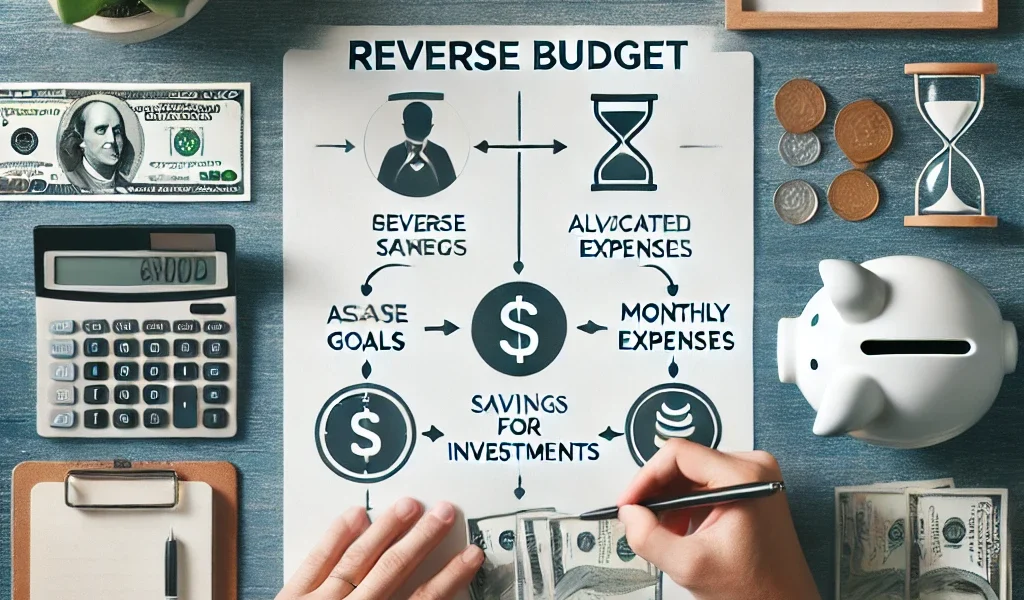📚 Introduction
Traditional budgeting methods often follow the spend-first, save-what’s-left model, which leaves little room for consistent savings. However, reverse budgeting flips this approach by prioritizing savings and investments first and then allocating what’s left for expenses.
By adopting reverse budgeting, you ensure that your financial goals remain the top priority, helping you:
✅ Achieve financial freedom faster
✅ Develop disciplined money management habits
✅ Prevent unnecessary spending by living within your means
This guide will cover:
👉 How reverse budgeting works and its benefits
👉 Step-by-step approach to implement reverse budgeting
👉 Practical tips to stick to your reverse budget and stay financially secure
We’ll also ensure the content is SEO-friendly, audience engaging, and legally compliant to safeguard against any legal complications.
🎯 What is Reverse Budgeting?
Reverse budgeting, also known as the Pay-Yourself-First Method, emphasizes saving and investing before covering any discretionary or non-essential expenses. Instead of adjusting your savings based on leftover income, you decide how much to save first and use the remaining amount for expenses.
📝 How Reverse Budgeting Differs from Traditional Budgeting
| Aspect | Traditional Budgeting | Reverse Budgeting |
|---|---|---|
| Priority | Expenses first, savings later | Savings first, expenses later |
| Goal | Avoid overspending | Build wealth and financial security |
| Flexibility | Spending flexibility | Disciplined financial planning |
| Impact on Financial Goals | Often delayed or inconsistent | Achieved faster with discipline |
💡 Why Reverse Budgeting is Essential for Financial Freedom
Reverse budgeting is not just about saving money—it’s about building a financially secure future and making conscious spending choices.
✅ 1. Consistent Savings for Financial Goals
When you allocate money for savings first, you create a consistent habit that keeps your financial goals on track.
✅ Build an Emergency Fund
✅ Grow your Investment Portfolio
✅ Secure your Retirement Corpus
✅ 2. Avoid Lifestyle Inflation
When income increases, expenses often rise in proportion. Reverse budgeting helps mitigate this by ensuring that a larger portion of the increased income goes toward savings rather than unnecessary spending.
✅ 3. Accelerate Wealth Creation
By consistently investing a portion of your income, you benefit from compounding growth over time. This accelerates your path toward financial independence.
📈 Step 1: Set Clear Financial Goals Before Starting
Begin by defining your short-term, medium-term, and long-term financial goals.
🎯 Short-Term Goals (0-2 Years)
- Build a ₹1 lakh emergency fund
- Pay off high-interest credit card debt
🎯 Medium-Term Goals (3-5 Years)
- Save for a down payment on a house
- Invest in diversified mutual funds
🎯 Long-Term Goals (5+ Years)
- Build a retirement corpus
- Grow passive income through investments
📝 Step 2: Decide How Much to Save First
Before allocating money for expenses, determine how much you need to save each month to achieve your goals.
📊 Recommended Savings Allocation
- Emergency Fund: At least 3-6 months’ worth of expenses
- Retirement Savings: 15-20% of your monthly income
- Investments for Wealth Growth: 10-15% toward mutual funds, SIPs, or other investment vehicles
📊 Example Calculation for ₹50,000 Monthly Income
- Emergency Fund Contribution: ₹5,000 (10%)
- SIP or Mutual Fund Contribution: ₹7,500 (15%)
- Retirement Account Contribution: ₹10,000 (20%)
✅ Total Savings: ₹22,500
✅ Remaining for Expenses: ₹27,500
📅 Step 3: Automate Savings and Investments
To make reverse budgeting seamless, automate transfers to savings and investment accounts as soon as you receive your salary.
🔄 1. Use Standing Instructions or Auto-Debit
Set up automatic transfers to:
- SIP Accounts: For mutual fund investments
- Recurring Deposits: For emergency fund contributions
- Retirement Accounts: To secure future financial stability
🔄 2. Create Multiple Buckets for Different Goals
Split your savings into multiple buckets based on goals. For example:
✅ Emergency Fund: 30%
✅ Investment Portfolio: 40%
✅ Retirement Fund: 30%
📊 Step 4: Create a Budget for Essential Expenses
After setting aside money for savings, create a budget for essential expenses using the remaining income.
📚 Recommended Budget Framework After Savings
| Category | Percentage | Monthly Allocation (₹) |
|---|---|---|
| Rent/Mortgage | 30% | ₹15,000 |
| Utilities and Bills | 10% | ₹5,000 |
| Groceries and Essentials | 15% | ₹7,500 |
| Discretionary Spending | 10% | ₹5,000 |
| Miscellaneous Expenses | 5% | ₹2,500 |
📉 Step 5: Cut Unnecessary Expenses and Adjust as Needed
Since you’ll have a limited budget for expenses after prioritizing savings, it’s essential to identify and cut unnecessary costs.
🚫 1. Evaluate Discretionary Spending
Look for non-essential categories that can be reduced or eliminated.
- Reduce dining out and opt for home-cooked meals.
- Cancel unused subscriptions and streaming services.
🚫 2. Negotiate Essential Expenses
Negotiate lower rates for internet, phone plans, and insurance premiums.
🚫 3. Avoid Impulse Purchases
Stick to a list when shopping and implement a 24-hour rule before making any non-essential purchase.
🔁 Step 6: Track Your Progress and Make Adjustments
Consistently monitoring your budget helps you stay on track with your savings and financial goals.
✅ Track Monthly Savings: Ensure you meet your monthly savings targets.
✅ Adjust Expense Categories: Modify allocations based on changing financial situations.
✅ Review Goals Annually: Update financial goals and tweak contributions if necessary.
🛑 Step 7: Avoid Common Mistakes in Reverse Budgeting
To ensure the success of your reverse budgeting approach, be mindful of these pitfalls:
🚫 1. Overcommitting to Savings: While saving is essential, ensure that you’re leaving enough for essential expenses.
🚫 2. Ignoring Emergency Funds: Don’t invest all your savings—maintain liquidity for emergencies.
🚫 3. Not Reviewing Budget Periodically: Financial situations change, so update your goals and adjust contributions regularly.
🎁 Bonus: Reverse Budgeting Template
| Category | Percentage | Monthly Allocation (₹) |
|---|---|---|
| Emergency Fund | 10% | ₹5,000 |
| Retirement Savings | 20% | ₹10,000 |
| SIP/Mutual Funds | 15% | ₹7,500 |
| Rent/Mortgage | 30% | ₹15,000 |
| Utilities and Essentials | 25% | ₹12,500 |
📢 Conclusion: Take Control of Your Financial Future with Reverse Budgeting
Reverse budgeting is an effective strategy for building long-term wealth and financial freedom. By prioritizing savings first and living within the remaining income, you:
✅ Secure your future through consistent savings
✅ Prevent unnecessary spending and maintain discipline
✅ Stay on track to meet financial goals with confidence
Pro Tip: Automate your savings to eliminate guesswork and ensure that you’re always prioritizing your financial future. Embrace reverse budgeting today and move closer to achieving financial independence! 🚀




